Gigasperma is an inactive genus of fungi in the order Agaricales with a single species. It was treated either as the only genus in the monotypic family Gigaspermataceae, or part of the wider Cortinariaceae. Gigasperma was circumscribed by Austrian mycologist Egon Horak in 1971.
Aeruginospora furfuracea is a species of fungus in the family Hygrophoraceae. The species, described by Egon Horak in 1973, is found in New Zealand. It is currently placed in the genus Aeruginospora, but may actually belong in Camarophyllopsis.

Underwoodia is a genus of ascomycete fungi in the order Pezizales. The widespread genus contained many species, beforre they were transferred to the Geomorium genus. The genus, described by Charles Horton Peck in 1890, honors mycologist Lucien Marcus Underwood.

Entoloma haastii is a mushroom in the Entolomataceae family. Described as new to science in 1964, it is known only from New Zealand, where it grows on the ground in leaf litter, usually near Nothofagus species.

Gliophorus is a genus of agaric fungi in the family Hygrophoraceae. Gliophorus species belong to a group known as waxcaps in English, sometimes also waxy caps in North America or waxgills in New Zealand. In Europe, Gliophorus species are typical of waxcap grasslands, a declining habitat due to changing agricultural practices. As a result, two species, Gliophorus europerplexus and Gliophorus reginae, are of global conservation concern and are listed as "vulnerable" on the IUCN Red List of Threatened Species.
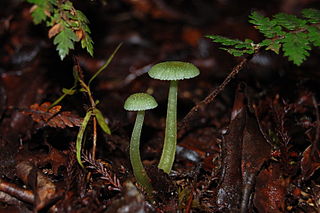
Gliophorus graminicolor is a species of agaric fungus in the family Hygrophoraceae. It is found in Australia and New Zealand. In 1995, Australian mycologists Tom May and Alec Wood transferred the species to Hygrocybe, but the taxonomic authority Index Fungorum retains it in Gliophorus.
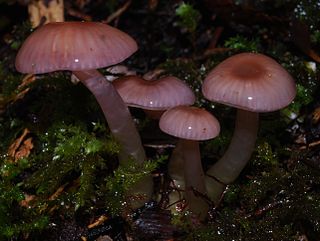
Gliophorus versicolor is a species of agaric fungus in the family Hygrophoraceae. Found in New Zealand, it was described as new to science in 1973 by mycologist Egon Horak. Within the genus Gliophorus, it is classified in the section Glutinosae, a grouping of species characterized by having bright colors, decurrent gills, and a gelatinized subhymenium. Fruit bodies have hemispherical to convex caps typically measuring 20 mm (0.8 in), although some have been recorded up to 50 mm (2.0 in). Moist caps are gluey with a color ranging from reddish brown to pinkish-lilac; the cap margin has radial grooves mirroring the gills underneath. The gills have an adnate to somewhat decurrent attachment to the stipe. They are widely spaced with color similar to the cap, or whitish. The cylindrical, hollow stipe measures 2–7 cm (0.8–2.8 in) by 1.5–3 mm (0.06–0.12 in) thick. The fungus is saprobic, and fruits on the ground among Dacrycarpus and Nothofagus.
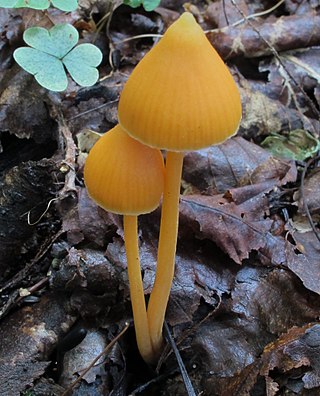
Entoloma quadratum is a species of agaric fungus in the family Entolomataceae. The fungus was originally described as Agaricus quadratus by Miles Joseph Berkeley and Moses Ashley Curtis in 1859; Egon Horak transferred it to Entoloma in 1976. It is found in Africa, Asia, Europe, and North America.

Tubaria rufofulva is a species of agaric fungus in the family Tubariaceae. Found in Australia, it was originally described in 1927 by John Burton Cleland as a species of Pholiota. The fungus was transferred to the genus Tubaria in 1983.
Egon Horak is an Austrian mycologist who has described more than 1000 species of fungi, including many from the Southern Hemisphere, particularly New Zealand and South America. He was an executive editor of the scientific journal Sydowia from 1975 to 1989, and a member of the editorial board afterwards.
Gliophorus bichromus is a species of agaric fungus in the family Hygrophoraceae. Found in New Zealand, it was described by mycologist Egon Horak in 1973.

Gliophorus laetus is a species of agaric fungus in the family Hygrophoraceae. Originally described as new to science by Christian Hendrik Persoon in 1800, it was transferred to the genus Gliophorus in 1958. It is considered edible, but of little interest.
Gliophorus pallidus is a species of agaric fungus in the family Hygrophoraceae. Found in New Zealand, it was described as new to science in 1973.
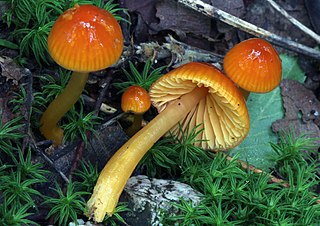
Gliophorus perplexus is a species of agaric fungus in the family Hygrophoraceae. It was first described in 1954 by American mycologists Alexander H. Smith and Lexemuel Ray Hesler as Hygrophorus perplexus.
Gliophorus pseudograminicolor is a species of agaric fungus in the family Hygrophoraceae. Found in Australia, it was originally described in 1997 by mycologist Anthony M. Young as a species of Hygrocybe and transferred to Gliophorus in 2013.

Gliophorus viridis is a species of agaric fungus in the family Hygrophoraceae found in New Zealand and Australia.
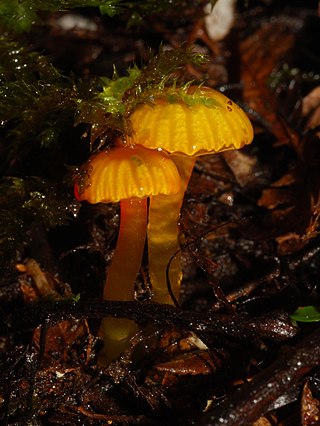
Gliophorus viscaurantius is a species of agaric fungus in the family Hygrophoraceae found in New Zealand.
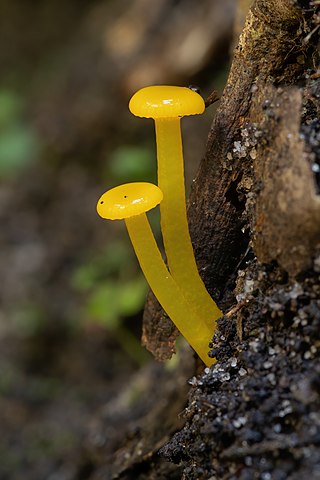
Gliophorus chromolimoneus is a species of agaric fungus in the family Hygrophoraceae found in New Zealand and Australia.
Volvanarius is a genus of fungi in the family Cortinariaceae.












